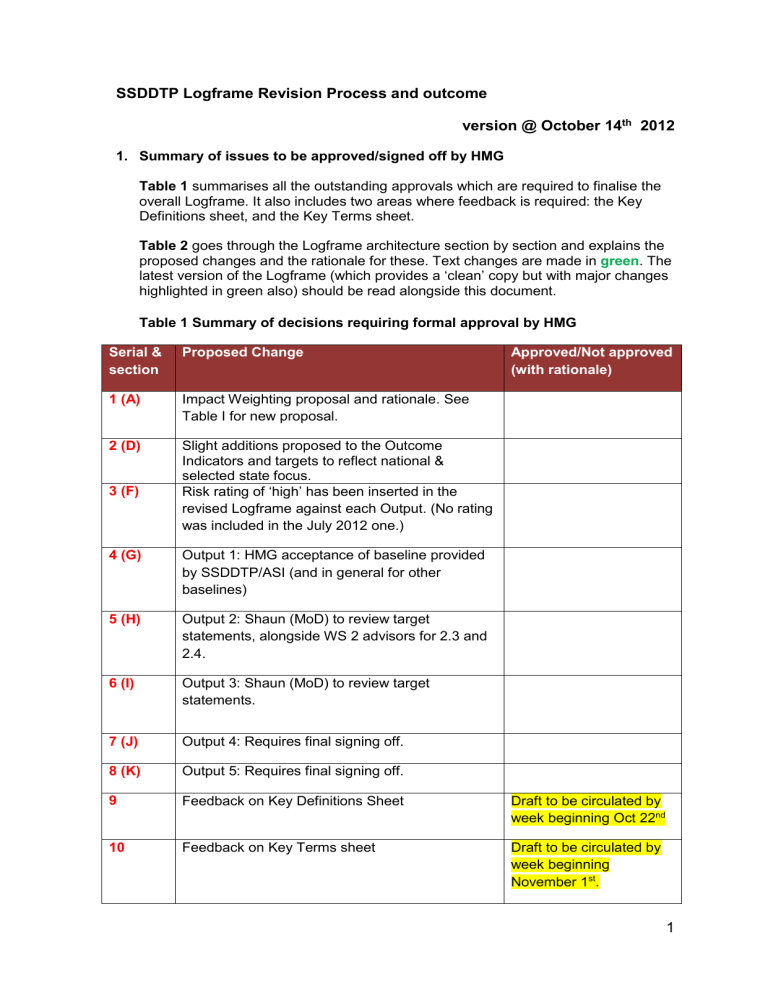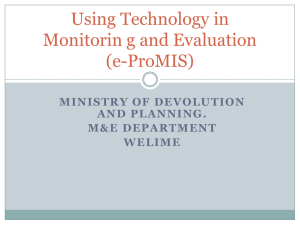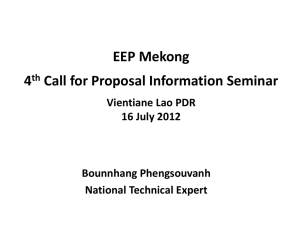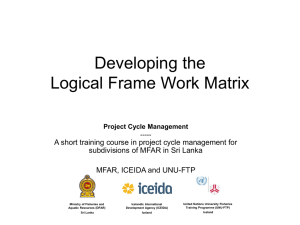Outputs - Department for International Development

SSDDTP Logframe Revision Process and outcome version @ October 14
th
2012
1. Summary of issues to be approved/signed off by HMG
Table 1 summarises all the outstanding approvals which are required to finalise the overall Logframe. It also includes two areas where feedback is required: the Key
Definitions sheet, and the Key Terms sheet.
Table 2 goes through the Logframe architecture section by section and explains the proposed changes and the rationale for these. Text changes are made in green . The late st version of the Logframe (which provides a ‘clean’ copy but with major changes highlighted in green also) should be read alongside this document.
Table 1 Summary of decisions requiring formal approval by HMG
Serial & section
Proposed Change Approved/Not approved
(with rationale)
1 (A)
2 (D)
3 (F)
4 (G)
5 (H)
6 (I)
7 (J)
8 (K)
9
10
Impact Weighting proposal and rationale. See
Table I for new proposal.
Slight additions proposed to the Outcome
Indicators and targets to reflect national & selected state focus.
Risk rating of ‘high’ has been inserted in the revised Logframe against each Output. (No rating was included in the July 2012 one.)
Output 1: HMG acceptance of baseline provided by SSDDTP/ASI (and in general for other baselines)
Output 2: Shaun (MoD) to review target statements, alongside WS 2 advisors for 2.3 and
2.4.
Output 3: Shaun (MoD) to review target statements.
Output 4: Requires final signing off.
Output 5: Requires final signing off.
Feedback on Key Definitions Sheet
Feedback on Key Terms sheet
Draft to be circulated by week beginning Oct 22 nd
Draft to be circulated by week beginning
November 1 st .
1
2. Introduction
During the week of October 8 th -14 th , HMG and DFID worked together to revise the
SSDDTP Logframe in line with the recommendations of the Annual Review report
(July 2012). All the changes outlined here relate to the July 15 th 2012 Logframe which was used as the basis of the Annual Review.
The process, however, built on work which had already resulted from collaboration between DFID’s Results & Stats Advisor and the ASI M&E team around the implications of the new DFID Scoring and Reviewing How To Note, and which included an SSDDTP M&E workshop in Uganda in January 2012 and the April 25 th
2012 SSDDTP Logframe Review document which redefined the Theory of Change and proposed a number of LF changes.
The main recommendations from the AR were to overhaul the Logframe so as to:
Align the Theory of Change with the Outputs, Indicators, Baselines and Targets;
Be realistic about what targets are within the gift or control of SSDDTP, and reset these for the end-of-programme horizon of December 2012;
Be more specific about the States in which SSDDTP has been working; refocus
Output 1 on National architecture, with Output 6 maintaining focus on States architecture;
Recalculate the Impact Weighting of each Output to reflect better the balance between cost, level of effort and anticipated impact;
Clarify the baselines and ensure that HMG accepts the baselines as described;
Update the assumptions to ensure that State level and National assumptions are explicit.
Specific recommendations were detailed in the AR for Outputs 1 and 6. In addition, it was recommended that the Staged Capacity Building Model, or a similar methodology, be used to help make explicit the incremental approach to supporting the development of capability in individuals, organisations and institutions relating to security sector reform.
3. The process of collaborative revision
Day 1: Tuesday 9 th October
The ASI M&E team (Beverley Jones and Lenny Gill) worked with DFID’s Results &
Statistics lead (Caroline Wangeci-Dale) to address the detailed recommendations for
Outputs 1 and 6. From this was developed a rubric for bringing the focus of the targets down from external changes in systems, policies, structures and events
(which are beyond the direct control of SSDDTP) to the quality and effectiveness of the contribution of SSDDTP ’s approach to the enhanced capability of South
Sudanese counterparts to deliver on those desired systems, policies, structures and events.
The ASI team spent the rest of the day applying the rubric across the two Outputs, and testing the same method on the first indicator of Output 2 and Output 3.
Day 2: Wednesday 10 th October
The DFID Senior Governance Advisor (Sonia Warner) and SSDDTP Team Leader
(Mark Etherington) joined the group to review and approve progress so far, and to
2
continue working across Output 2 and 3 to ensure that HMG ’s expectations for delivery by Dec 2012 are explicit.
From this, a useful discussion of the characteristics of counterpart capability was drawn out. The key characteristics include : ‘Ownership’, ‘Planning, Delivery &
Problemsolving’, ‘Decision-making’, ‘Awareness/Knowledge & Understanding’.
These terms now feature (to different degrees) in the evidence sought for all targets in the Logframe.
It was agreed that the ASI team will develop a draft glossary of meanings from which
DFID and ASI together will produce a common understanding of both the characteristics of capability, and the approaches that SSDDTP is using to nurture these characteristics . This will be included in a summary sheet to the Logframe (as well as being included as an Annex to this document) and will inform the evidenceverification process of the Programme Completion Review team.
The ASI team spent the remainder of the day consulting with ASI workstream advisors to revise the Output 2 and 3 targets.
Day 3: Thursday 11 th October
Owing to a major SPLA conference with donors on Transformation the proposed
Logframe workshop was curtailed, and participation similar to Wednesday. Formal presentation was made by the ASI team to demonstrate both the changes proposed and the implications both for ASI in its exit strategy, but also the Programme
Completion Review which will take place in December. During this meeting it was agreed that:
The rubric for bringing targets ‘within purview of SSDDTP’ will be applied across all outputs;
Obsolete indicators and milestones already passed will be archived in the revised logframe by being shaded in grey;
The ASI team will demonstrate different ways in which impact weighting can be presented, and recommend a final set of weightings for the Outputs which will relate to the Outcome indicators. Once agreed, the rationale for the weighting will be included as a supplementary sheet to the Logframe;
The ASI team will pull together and circulate working definitions for counterpart capability and SSDDTP approach. These, once agreed, will be included in the ToR of the review team and will be included as a supplementary sheet in the Logframe (Key
Definitions Sheet) ;
Lesson learning will be the primary focus of the PCR. ASI agreed to pull out from documentation prepared for the Annual Review the main learning points – so that
HMG can identify any gaps in learning.
The term ‘Oversight’ requires a fuller discussion, including with counterparts, to provide a definition which is firmly rooted in South Sudanese understanding. It is proposed that ASI develop a working draft which can be elaborated through further discussion. (Key Terms sheet)
Aim to have Logframe finalised by Wednesday 17 th October (although final details may need to be incorporated thereafter).
3
4. Illustration of the method of revising Dec 2012 targets
Diagram 1 demonstrates the method for bringing outputs more within the control of the programme, based on the revised SSDDTP Theory of Change. All targets now start with ‘Evidence that the SSDDTP Mentoring & Levering approach contributes to x Capabilities in Counterparts ’ – which in turn can lead to changes in delivery of security sector transformation.
•SSDDTP Mentoring &
Levering Approach &
Methods: advising, training & teaching, modelling, responsiveness etc. contributing to.....
Outputs
Outcome
•....enhanced capability of Counterparts: ownership, problemsolving, delivery of somef transformation, leading to....
•....reforms and higher level delivery of Security
Sector Reform:
Architecture,
Transformation,
Oversight
Impact
Diagram 1 Setting the level
Diagram 2 illustrates the challenge that this presents. SSDDTP will need to be much more explicit about the tools and approaches it deploys in each context, why the choice was made, what evidence there is for showing the quality and effect of this engagement. This will be reflected in the final reports from advisors for this phase.
Training &
Teaching
Modelling
What does this look like and when is it helpful for counterparts?
What does this look like and when is it helpful for counterparts?
What evidence to show it has taken place? What evidence of quality & effect?
What evidence that it has taken place? What evidence of quality & effect?
Diagram 2 Breaking down the SSDDTP approach – 2 examples
4
A full powerpoint presentation is available to demonstrate the sequence in more detail.
5. Developing a learning agenda
Throughout the revision exercise, issues surfaced and were considered likely topics for the learning review planned for early December. This includes areas like the slow build approach to financial management capability, the issue of legitimacy for the
MoDVA, the extent to which either SPLA or MoDVA demonstrate ownership of transformation, and the role of strategic communications. DFID also highlighted some of the risk areas which will be considered in more depth in the learning review.
The ASI team agreed to draw out from all the inputs of advisors to the Annual
Review, key reflections and lessons. This will help HMG and ASI to identify where there are specific issues which warrant deeper exploration, including any gaps in learning which could be covered by the team.
5
Table 1
Record of revisions made and rationale for revision.
All proposed changes in LF-related text in green .
Specific recommendation
Action taken
A. Impact weightings (1)
The AR recommended that the Logframe review process should include recalculation of the Impact
Weighting. This is because the current figures are a compromise between two logframes which only came together this year; and the weightings do not present a balanced picture of the levels of investment (time, cost and effort) of a programme which is nearly four years old. The task of developing an Impact Weighting can be achieved in different ways and is not simply a matter of retrofitting expenditure because of the different cost drivers involved.
The ASI M&E team has been asked to present different ways of looking at the weighting of the programme, and to come up with a recommendation for approval. This has been achieved by going through five steps outlined below, and summarized in Table I below. In line with DFID discipline on
Impact Weighting, all but the actual costs have been rounded to the nearest 5. Each step corresponds with the respective column in the Table.
Step 1 The July 2012 LF Weighting
The weighting of the July 2012 Logframe was finalized just before the Annual Review, and was achieved through an integration of the LF for Workstreams 1-5 (which totaled 90 rather than 100% – probably based on weightings decided by HMG in 2009) and the separate LF for Workstream 6. WS 6 was given 10% to make up the balance when both parts of the programme were put together, a weighting which appears far lower than the level of investment made since 2010 when the Workstream started, or the growing importance of state-level engagement.
Step 2 The costs per Output to date
The alignment between each workstream and each output has the advantage of making it much easier to show exactly how much is being spent per output. Figures from Feb 2009 to Aug 2012 show that spend on Output 6 (at 38.5%) was almost four times as much as the retrospective allocation of weighting, and that spend on Outputs 3, 4 and 5 were correspondingly lower. This provides a distorted picture, however, in at least two ways.
Step 3: Cost drivers
Firstly the outputs are arranged according to primary counterparts (SPLA, MoDVA, Parliament, CSOs etc.) rather than against the main thematic priorities of the programme. A weighting by cost does not reflect the way in which activities across Outputs contribute to different themes.
Secondly, from 2010 and the arrival of Workstream 6 (Output 6), there has been growing emphasis on state security architecture and state capability in response both to specific events requiring stabilization support (Election, Referendum, Independence), and to the growing decentralization of the new South Sudan state. Column 3 shows how Output 6 and 5 relate to state-level activities which inevitably cost more because of travel costs which SSDDTP has not been able to off-set from other providers.
Step 4: Disaggregating indicators by theme & Outcome indicator
Looking at the programme from a thematic perspective enables us to introduce another dimension to
6
Specific recommendation
Action taken weighting. The three most obvious themes are: I) National & State Architecture, II) SPLA & MoDVA
Transformation and III) Oversight & Accountability. These themes are also reflected in the two
Outcome level indicators. These are incorporated as rows in Table I, and the sequence of Outputs shows where each Output relates primarily to each theme.
It is not, however, an exact ‘fit’. For example, Output 3 work done to promote financial management and anti-corruption in SPLA contributes to Oversight and Accountability, as does work with MoDVA on its responsiveness to Parliamentary requests. Work with civil society and state security committees under Output 6 also contributes to Oversight and Accountability. It is therefore possible to disaggregate the indicators under each Output and assign them to one of the three themes. By so doing, a slightly different weighting is established.
Step 5: Achieving final weighting proposal
On the basis of the proportion of each output’s indicators which fall under each theme, it is possible to use the overall cost for that Output (under column 2) to re-aggregate back to a slightly revised weighting for each Output. For example, if Output 3 indicators are split equally between theme 2 and
3, then 50% of the cost of that output is allocated to each. This reduces the weighting of Output 3, but increases the weighting of either Output 4 or Output 5 (relative to the spend). Again, this is not precise but by looking at the actual spend in relation to each output under each theme, a judgement can be reached about how much to reduce or increase the weighting for each specific output.
Table I
Steps
Different ways of viewing data
1
% July ’12
LF weighting: combined
OPs 1-5
2
%
Financial investment
Feb 09 to
Aug 12
3
% Division between
National
& Juba and OP 6 activity
Outcome indicator 1 (revised)
…
State level activity
Security decision making architecture at national and (selected) state level.
Output 1 10 5 100 0
Output 6 10 38.5 25 75
Outcome Indicator 2
Effectiveness, accountability and affordability of the SPLA; effectiveness of democratic oversight of the security sector (national & specific states)
Output 2 30 29.6 100 0
Output 3 100 0 25 13.4
Outcome Indicator 2
Effectiveness, accountability and affordability of the SPLA; effectiveness of democratic oversight of the security sector (national & specific states)
Output 4
Output 5
10
15
4.4
9.1
85
25
15
75
Totals 100% 100% 70 30
4
Disaggregated output indicators (showing
% proportion against whole) grouped under Outcome
Indicator/theme
5
% Final proposed weighting by output (with thematic proportion in red)
I. Nat & State Architecture
= 35%
1.1, 1.2, 1.3 (100%)
6.1- 6.6 + 6.8 (87%)
5%
30%
II. SPLA & MoDVA Transformation
= 40%
Relevant indicators
2.1-2.5 (100%)
3.1, 3.2 (50%)
25%
15%
III. Oversight & Accountability
= 25%
Relevant indicators
4.1 (100%),
5.1-5.2 (100%),
3.3, 3.4, (50%),
6.7 (12%)
10%
15%
100%
7
Specific recommendation
Action taken
Implications of the proposed new weightings:
The proposed new weightings achieve a better balance between the three main themes of SSDDTP in a number of ways.
The high costs of travel in the states (incurred under Output 6) are less distorting of the whole picture. At the same time, with a weighting of 30%, the significance of Output 6 is now more appropriately integrated into the overall picture.
The benefits of a more integrated approach which has emerged in the last two years of
SSDDTP is now better reflected in how the disaggregated indicators at Output level contribute to the Outcome level indicators.
While Outputs 4 and 5 now have the same weighting as the original allocation, the weighting for 1, 2 & 3 have reduced slightly (between 5% & 10%). This does not reduce their importance for the programme but better reflects the scale of investment in both Outputs 1& 3, as well as mitigating the risk of the whole programme being underscored for changes in architecture and transformation which are too dependent on factors beyond the control of the programme.
B. Theory of change (updated from April 2012)
Output level
• “The mentoring and skills development of a critical mass of key individuals in the military, parliament, government and civil society (at national level and in selected states)…
• “…combined with the facilitation of productive relationships between these actors, coordination and leverage with other international actors, and support for institutional development…
Outcome level
• “…will contribute to the development of ownership, understanding, decision-making, planning, delivery & problem-solving capability of South Sudan SSR actors…
Impact level
• “…which will contribute to a security sector which is more strategic, skilled, organized and better behaved, and more respon sive to the security priorities of its citizens.”
Changes proposed and agreed:
1. The Theory of Change developed at the January 2012 M&E workshop is the base text, to which has been added the section in green. The overall statement has been aligned with the
Logframe hierarchy of objectives. Outputs now focus more explicitly on the effectiveness of the contribution of SSDDTP to changes in counterparts. The Outcome focusses more on the evidence that counterparts own and deliver their own transformation and oversight policies, structures and events.
2. Note that in the revised Logframe, targets at Output level include both the contribution of
SSDDTP, and what it is hoped that this contribution will lead to (specific changes delivered by counterparts) even though the latter are largely outside SSDDTP’s control. This is because, at such a late stage in the programme, it is inadvisable to lose core text which has been for so long retained in the Logframe. If this Logframe were being developed from scratch, there would be a much clearer separation between output and outcome level expectations.
8
Specific recommendation
C. Assumptions
Action taken
Assumptions should be included at national and state level – and reflecting risks
Assumptions to be updated for current realities
Changes agreed:
1. At Outcome level, 5 generic updated assumptions from April 2012 now replace the obsolete or too specific assumptions from previous version.
In addition, a sixth assumption is included to reflect a key trend:
6 th assumption: South Sudan operates as a de facto decentralised state (as per Constitution Section 1.4) and the existing and emerging structures and systems of South Sudan's states can be harmonised with emerging national policies and structures.
2. These assumptions are adopted at Output level also. In addition, selected state level assumptions are now included against Output 6.
D. Outcome (2)
Relevant section of ToC
“…will contribute to the development of ownership, understanding, decisionmaking, planning, delivery & problemsolving capability of
South Sudan SSR actors…
Changes agreed:
1. No change to the Outcome Statement, but slight additions proposed to the Outcome Indicators and targets: Changes are proposed to: a) ensure state level investments are reflected; b) incorporate ‘ownership’ and ‘inclusion’ concepts, and make
‘oversight’ rather than ‘control’ more specific; c) indicate on-going change processes (rather than completed endpoints).
2. Indicator 1 : ‘Effectiveness of Government of RSS security decisionmaking architecture at national and state level.’
Targets:
1. GoSS at national & state level is develop ing and owning a comprehensive Security Strategy to fit political, security and fiscal context following the its independence;
2. Security decision making architecture and systems is becoming increasingly effective, inclusive , coherent and accountable.
Supported by strengthened analytical, policy development and coordination capacity. (See Key Definition sheet for terms.)
3. Indicator 2: ‘The effectiveness, internal accountability and affordability of the SPLA and the effectiveness of the MoDVA . and the effectiveness of democratic civil oversight control of the security sector.
Targets: Unchanged.
4. Ideally, the Oversight and Accountability effect of the programme would have been looked at through a separate Outcome indicator, reflecting the overall balance of the programme. This would also align more logically with the rationale for the Impact Weighting (see above). In view of the late stage of the programme, it is inadvisable to change anything
9
Specific recommendation
Action taken of substance at Outcome level. The PCR Review team will therefore be asked to look at the extent to which Oversight and Accountability is supported across the programme. More work will be done to provide a working definition for Oversight which resonates with counterparts.
E. General
Changes agreed:
1. Previous milestones between baseline and targets have been retained but archived (in grey) as part of the history of SSDDTP and its previous reviews.
2. Indicators are now all prefaced with the words ‘Support for…’ and in some cases verbs are changed to present continuous to demonstrate that the process is still on-going.
3. Target formulation adopts a common rubric across all outputs, even for those indicators which ‘met expectations’ in the Annual Review in
August. This is because most of the Dec 2012 targets across all indicators are not within the control of the programme – which also means that if these current indicators are met, it will not be clear the extent to which SSDDTP’s efforts were a contributing factor.
4. Targets now focus on:
Evidence that the SSDDTP Mentoring & Levering Approach
(coaching, training, reminding, skills transfer, modelling, coordinating etc …) contributes to…
Enhanced capabilities in counterparts & Influence on others, leading to…
Change or foundations/preparation for change
5. The AR asked HMG to verify the baseline data provided by SSDDTP.
This has not yet been done although there does not appear to be a major issue.
F. Risk rating in Logframe (3)
Changes proposed and needing sign-off:
Risk ratings have been lost from the July 2012 Logframe. According to the AR of July 2012, all Outputs are considered High risk. This is what has been recorded in the revised Logframe.
G. Output 1 (4)
1.5 Targets less ambitious, measurable, and assessed against a clear baseline that reflects existing realities against the various components of the target. Focus
Changes agreed:
1. HMG confirmed its preference for an NSP process which is broadbased and inclusive, rather than a process which emphasizes delivery of a document over inclusive process. This informs revision of targets for this Output.
2. ‘Oversight’ is preferable to ‘control’ (in Output statement) because less likely to create misunderstanding.
10
Specific recommendation should be national, with state level coherence reflected only in Output 6.
1.6 Targets for third indicator realigned to reflect significant challenges of securing agreement on a new architecture at both national and state level.
Action taken
3. Targets for all three WS indicators now focus on the evidence that the
SSDDTP Mentoring & Levering Approach is contributing to desired changes in counterparts’ systems, commitment and capability to deliver the National Security Policy inclusively, and the systems and architecture for supporting implementation of the NSP. (The previous targets focused on delivery of the NSP and NSP architecture and capacity, all of which are not within the gift of SSDDTP. The source of evidence will be examples of communication by GOSS leadership, minutes, workshop reports, case studies etc.)
4. Baseline data provided by SSDDTP needs to be accepted by HMG.
1.7 Assumptions need to be updated to reflect state level challenges.
H. Output 2 (5)
2.1. Consideration should be given to linking the
Log- Frame Indicators and Milestones in Workstream 2 more closely to the planned outputs and outcomes of the SPLA
Transformation Strategy and Objective Force
2017.
Changes agreed but requiring sign-off from Shaun, and final input from
SSDDTP workstream advisors (Mike & Charlie):
1. Same rubric applied to all four indicators and targets.
2. ‘Doctrine’ is removed from 2.1 target on DFID’s advice because this is not the focus of SSDDTP support. Language of indicators and targets
(for this Logframe) has not be aligned with the language of the
Transformation Strategy because the Tx Strategy is itself a product to which this workstream this contributed; this point will be taken forward into the next phase.
3. 2.2
indicator and target has incorporated a more explicit reference to gender and human rights.
4. The main assumption for 2.3
did not hold. Proposed wording for 2.3
Logistics follows the standard rubric, and emphasizes the building blocks of a transparent, efficient and accountable logistics capability for
SPLA, characterized by number of key changes which are ‘in train’.
These need to be confirmed by the relevant advisor (Mike Edwards).
Suggested rewording for 2.3:
Evidence that SSDDTP's mentoring and levering approach contributes to enhanced ownership, decision-making, responsiveness, planning, delivery and problem-solving skills of SPLA counterparts:
Leading to the development of the main building blocks of transparent, efficient and accountable SPLA logistics capability in these areas: a) Managing logistics training with external support; b) Priority elements of SPLA Logistics Brigade are being implemented with key equipment and manpower. c) Selected Divisions in the process of ceding control of divisional stocks and supply responsibilities to the Logistic Support Brigade; d) Plans being developed to deliver Logistic procedural handbook to all
SPLA units, and put in place enforcement mechanisms; e) SPLA in process of preparing technical specifications /user
11
Specific recommendation
Action taken requirements to support key equipment procurement plans, with view to endorsement; f) SPLA in process of developing a detailed plan to transfer responsibility for running logistic training at Lainya from PAE to Logistic
Branch.
5. For 2.4
, some targets (as described in the July 2012 Logframe) have already been achieved. This is noted in blue. Others have been reframed according to the new standard rubric with some changes to words to show that processes are on-going. Those relating to DDR have been removed on DF
ID’s advice. The revised wording needs to be confirmed by the workstream advisor Charlie Stagg.
Target rewording:
Evidence that SSDDTP's mentoring and levering approach contributes to enhanced ownership, knowledge/awareness, decision-making, planning and execution on the part of SPLA counterparts:
Contributing to: a) The establishment of an Administration Training Centre providing
Human Rights and Gender aware training in respect of administrative processes and procedures (Now complete as PAE are now running this.) b) An Administration Branch which is able to identify and implement organisational changes required by Transformation Strategy. c) The operationalisation of a HRIS at an initial operating capability level. d) SPLA IT data-entry staff working towards optimum capacity to digitise personnel information files. e) SPLA initiating delivery of IT Data
Entry courses.
6. Indicator 2.5 (on strategic communications) has been archived (in grey).
Learning from this experience will go into the Lesson Learning exercise.
I. Output 3 (6)
Strategic
Communications reinstated?
Changes agreed but requiring sign-off from Shaun:
1. Same rubric applied to all indicators and targets.
2. 3.1, 3.2 and 3.3
follow this pattern relatively easily.
3. For 3.4
, the complexity of the term ‘oversight’ was reviewed. The term
‘democratic oversight’ has been revised to ‘oversight’ because expectations around ‘democratic oversight’ appear too ambitious/unclear at this stage. (Is this an issue also for the Outcome
Indicator 2?). It is proposed that HMG/ASI develop a working definition based on perceptions of key counterparts to assist the review team.
The targets have been revised to be aligned ore clearly with the indicator.
Revised Indicator 3.4
Support for the Ministry’s commitment to and action on democratic
12
Specific recommendation
Action taken oversight of the SPLA, and the strength of the Ministry's coordination with other GoSS oversight institutions.
Proposed revision of targets:
Evidence that SSDDTP's mentoring and levering approach contributes to enhanced ownership, knowledge/awareness, responsiveness, planning and execution skills on the part of Ministry counterparts:
Leading to: a) Increased development of the Ministry's concept of oversight of
SPLA, their understanding of their role in oversight and the mechanisms required for oversight, including coordinating relationships with other GOSS bodies with oversight responsibilities. b). Evidenced commitment to financial accountability through internal audit, and increased understanding within all Ministry directorates about how to work with the Finance Directorate. c) Developing awareness of the implications of gender inequality and
Human Rights.
J. Output 4 (7)
No specific recommendation but comes under general.
Changes agreed but requiring final sign-off:
1. Same rubric applied to the one indicator under this Output.
2. No substantive alterations to any of the key changes to which enhanced capability will lead.
K. Output 5 (8)
No specific recommendation but comes under general.
Changes agreed but requiring final sign-off:
1. Same rubric applied to the three indicators and targets under this output.
2. Some slight qualification of the Indicator, and some qualifications to the
5.1
targets where it relates to changes in behaviours of CSOs and security sector.
Proposed revision to 5.1 indicator: Support provided to selected civil society organisations to enhance the quality of their engagement with , and influence over, security sector governance and activities.
3. Likewise 5.2
.
Revised Indicator: Support provided to selected civil society organisations to improve their core functions and enable them to better engage in defence and security debates, to contribute to policy development and to monitor the performance of security sector agencies
L. Output 6
Confused focus: is it
‘Strengthening GoSS
Strategic Security
Planning’ or human security at state level
Changes agreed:
Steps taken to align Output 6
13
Specific recommendation or development and sustainment of effective information system for security decision making at state and federal level.
Significant duplication across indicators and associated targets.
Ability of the programme to operate within each state will differ, as will the capacity of the SSCs and the security challenges and opportunities.
Helpful if in the final six months of the programme, the overall output’s intent could be clarified between HMG and
SSDDT; reduce number of indicators; make measurable targets specifically focused on selected states and programme’s purview to influence.
Difference in progress between targets that are supply driven, and targets that are driven by demand. Retain a balance between supply-driven and demand driven targets, but to investigate why those demand driven targets are not always being met.
Action taken i) ii) iii) iv) v)
Clarifying Output statement: the primary focus is support to: Internal security structures at state level in South Sudan to plan and implement human security, underpinned by a support system which provides timely, accurate, relevant and analysed information to decision makers within state government. Indicators are now aligned with this focus.
Those indicators which relate to the now defunct JOC system have been retained but ‘archived’ by being shaded in grey. These are 6.2,
6.3, 6.4, 6.5, 6.6 (July LF)
Indicators now make explicit the states in which SSDDTP is providing support.
The assumptions now include reference to state specific dynamics.
Targets for ‘live’ indicators have been reviewed with the focus moving from external changes in behaviours, systems and structures to evidence of SSDDTP’s contribution to those changes. vi) Of the ‘live’ indicators, 6.1 and 6.8 are effectively the same so have been merged into 6.1, and 6.10 has been merged with 6.9. This means that there are now 3 ‘live’ indicators out of 8 overall indicators until the end of the project. These are renumbered as:
6.1, 6.7 and 6.8.
vii) Indicator 6.7 (July LF & revised) makes more explicit SSDDTP’s support for state security structures to harmonise with SSNPS policies. SPLA is removed from this because SPLA is hardly present in state security structures, and where it is, SSDDTP does not have a direct interface with it. It also emphasizes civil society engagement in oversight of local structures. This is why it is considered appropriate to include under the Oversight and
Accountability theme under the Outcome indicator. (See Impact weighting section.) viii) The supply-demand tension is addressed by making more explicit the underlying theory of change re. moving from dependent to independent counterparts (or ‘intelligent customers’ of external services). This is similar to the Staged Capacity Building Model,
14







